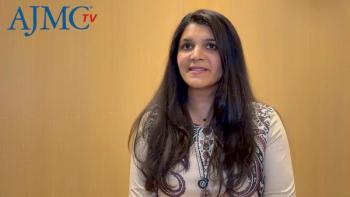
- October 2024
- Volume 30
- Issue 11
- Pages: SP824-SP825
Institute for Value-Based Medicine®: Speakers Use AML Studies to Illustrate Effects of Disparities, Neighborhood Stress on Outcomes
Key Takeaways
- Neighborhood disinvestment, characterized by infrastructure deterioration, is linked to increased stress and adverse cancer outcomes, necessitating further research.
- Racial disparities in acute myeloid leukemia (AML) outcomes are influenced by structural racism and genetic mutations, such as TP53, affecting survival rates.
Coverage from the Institute for Value-Based Medicine session at Ohio State University. This article will appear in the October issue of Evidence-Based Oncology.
The interplay among genetics, social factors, cancer risk, and outcomes has been a focus of recent oncology research. These associations drove the discussion at the August 1, 2024, session of the Institute for Value-Based Medicine® presented in partnership with The Ohio State University Comprehensive Cancer Center (OSUCCC). Speakers called attention to the glaring disparities in outcomes seen among different demographic groups, given the toll from factors such as socioeconomic, neighborhood and environmental stress, access to care, and genetic variability. Presenters also emphasized the dire need for more data collection, calling extra attention to discrepancies in trial enrollment that skew these research considerations.
Jesse John Plascak, PhD, MPH, coleader of the Cancer Control Program at OSUCCC, kick-started the conversation by contextualizing the long-standing research history, which recognizes how adverse neighborhood conditions affect cancer outcomes. These circumstances are typically measured through perceived stress, whether exacerbated through socioeconomic compositions, degrees of racial-ethnic segregation, or health care access. Plascak, however, highlighted the value of quantifying neighborhood disinvestment, which he argued is an understudied research consideration.
Plascak characterized disinvestment as “infrastructure deterioration within neighborhoods and associations with health behaviors and health outcomes,” meaning dilapidated landscapes, buildings, or other forms of disrepair. To evaluate these conditions, he and his lab utilized Google Street View images to conduct virtual audits across 23,000 locations. Yard and building conditions, garbage, dumpster availability, graffiti, and more were analyzed and used to create a disinvestment composite score.1 The disinvestment scores were then applied to datasets with geological reference, meaning they could assess even unobserved areas’ disinvestment levels.
Further investigation, with a focus on breast cancer survivors, revealed that high disinvestment was associated with increased stress,2 shortened survival time,1 and detrimental health behaviors such as increased consumption of sugar-sweetened beverages.3 These results show that “living in disinvested neighborhoods is a chronic stressor” that Plascak said merits more attention in cancer research.
AML as a Starting Point
Irum Khan, MD, MS, associate professor of medicine at the Feinberg School of Medicine, Northwestern University, expanded on Plascak’s perspective as she drew attention to the intersection of racial disparities and genetic mutations in acute myeloid leukemia (AML). “Where you live can impact your leukemia,” she asserted.
Khan’s research investigated influential domains in leukemia outcomes, a subject motivated by the racial segregation she witnesses in Chicago and informed by Bhatnagar et al’s 2021 report that illustrated the growing survival disparities between White and Black patients.4 Her findings suggested that structural racism directly impacts survival outcomes in AML.5
After adjusting for neighborhood-level factors (affluence, disadvantage, segregation, etc), racial disparities in their Chicago cohort notably shrunk in elements associated with adverse leukemia outcomes: tumor biology, health care access, treatment, comorbidities, and intensive care unit admission.
“Some of this is largely due to stagnation of survival for the Black patients that may not be benefiting from some of the therapeutic advances we’re making,” Khan commented, but Bhatnagar et al’s findings also suggested that molecular characteristics play a role.4 With the advancement of gene sequencing, TP53 mutation stands out as one of the more adverse risk mutations in leukemia. This variation contributes to disproportionately poor survival rates and chemotherapy resistance compared with other malignancies and has become increasingly prevalent in Black patients.
Diversity Within Hispanic Population
The value of gene sequencing was further emphasized by Monica Guzman, PhD, associate professor at Weill Cornell Medicine, whose presentation detailed how ancestry-based assessment could change clinical approaches to cancer care.
Guzman began by noting the implications an AML diagnosis can have for Hispanic patients. As highlighted by a 2017 report, Hispanic patients with AML have shorter survival outlooks and younger ages of presentation compared with White patients.6 These results underscore the need to investigate the potential drivers of leukemia outcomes in Hispanic patients; however, Guzman drew attention to the fact that deriving data from self-reported “Hispanic” patients cannot adequately describe the population. “‘Hispanic’ is a very diverse group of people. It’s an ethnicity, and the race can be very different.” A generalized classification thus dismisses the vast heterogeneity of Hispanic ethnicities and complicates the assessment of disparities.
Guzman then referenced a study from 2018 that had major implications for AML research and clinical practice: leukemia can be predicted.7 These findings indicated that preexisting mutations could be detected 10 to 15 years before leukemia develops. This discovery carries significant weight for Hispanic populations, Guzman argued, because AML’s characteristics and Hispanic patients’ genetic variations differ significantly, as demonstrated by a 2016 report.8
Better mapping of the mutational landscaping of this population, Guzman posited, could shed light on leukemia’s mechanism of transformation and help future research more effectively gauge the influence of social or environmental health determinants.
White Patients Dominate the Data
Another staple of Guzman’s presentation was calling out the prevalence of data derived from Caucasian cohorts. Representation remained a poignant topic for Andrew Hantel, MD, an instructor in medicine at Harvard Medical School and faculty member in the divisions of Leukemia and Population Sciences at Dana-Farber Cancer Institute. Hantel surveyed the state of research participation in AML, highlighting the underrepresentation of certain demographic groups. He also explored the role of structural and institutional racism, echoing Khan’s earlier discussion.
“We think about participation disparities as kind of a difference between the condition-specific representation of participants compared to how that same population kind of makes up the proportion of a population,” Hantel began. The disparity itself, he clarified, is more of a “downstream outcome” that needs deeper considerations because “there are a whole bunch of things that are actually mediating this difference that we see in the end,” such as a plethora of patient-level factors and systematic barriers rooted in policy.
In 2021, a study conducted by Hantel and colleagues found that non-Hispanic Black and Hispanic patients have significantly lower odds for enrolling in acute leukemia trials compared with non-Hispanic White patients—and this disparity has worsened over time.9 At the patient level, trial availability remains an essential step for addressing these outcomes; however, even when improving availability, additional factors such as patient’s eligibility or—if eligible—their desire and ability to pursue enrollment need more attention.
Access may inflate this issue, according to a 2022 analysis showcasing how minority groups are geographically alienated from AML trials that are conducted too far from their residences.10 Yet, Hantel continued, even where access isn’t a barrier, persistent disparities in who enrolls in trials call into question the influence of eligibility criteria or interpersonal bias on patient exclusion.
Policy Affects Outcomes
When confronting these components, Hantel argued the importance of a “policy-down-to-person” approach, such as the expansion of Medicaid and cost coverage, which has been demonstrated to increase the enrollment rates of Black and Hispanic patients.11 Additionally, Hantel highlighted the importance of diversity action plans and trial interventions to identify exclusionary criteria, evaluate institutional enrollment trends, and engage community boards to address patient burdens.
Overall, the speakers’ presentations emphasized the advantages of and need for multifaceted approaches in oncology—ones that consider social and environmental factors alongside genetic insights to tackle patients’ needs. Advancing cancer care and minimizing disparities remains a complex venture that requires more comprehensive data, inclusive research practices, and the sustained determination to meaningfully impact patient outcomes.
References
1. Plascak JJ, Rundle AG, Xu X, et al. Associations between neighborhood disinvestment and breast cancer outcomes within a populous state registry. Cancer. 2022;128(1):131-138. doi:10.1002/cncr.33900
2. Plascak JJ, Llanos AAM, Qin B, et al. Visual cues of the built environment and perceived stress among a cohort of Black breast cancer survivors. Health Place. 2021;67:102498. doi:10.1016/j.healthplace.2020.102498
3. Plascak JJ, Desire-Brisard T, Mays D, et al. Associations between observed neighborhood physical disorder and health behaviors, New Jersey behavioral risk factor Surveillance System 2011-2016. Prev Med Rep. 2023;32:102131. doi:10.1016/j.pmedr.2023.102131
4. Bhatnagar B, Kohlschmidt J, Mrózek K, et al. Poor survival and differential impact of genetic features of black patients with acute myeloid leukemia. Cancer Discov. 2021;11(3):626-637. doi:10.1158/2159-8290.CD-20-1579
5. Abraham IE, Rauscher GH, Patel AA, et al. Structural racism is a mediator of disparities in acute myeloid leukemia outcomes. Blood. 2022;139(14):2212-2226. doi:10.1182/blood.2021012830
6. Darbinyan K, Shastri A, Budhathoki A, et al. Hispanic ethnicity is associated with younger age at presentation but worse survival in acute myeloid leukemia. Blood Adv. 2017;1(24):2120-2123. doi:10.1182/bloodadvances.2017007013
7. Desai P, Mencia-Trinchant N, Savenkov O, et al. Somatic mutations precede acute myeloid leukemia years before diagnosis. Nat Med. 2018;24(7):1015-1023. doi:10.1038/s41591-018-0081-z
8. Gómez-Almaguer D, Marcos-Ramírez ER, Montaño-Figueroa EH, et al. Acute leukemia characteristics are different around the world: the Mexican perspective. Clin Lymphoma Myeloma Leuk. 2017;17(1):46-51. doi:10.1016/j.clml.2016.09.003
9. Hantel A, Luskin MR, Garcia JS, Stock W, DeAngelo DJ, Abel GA. Racial and ethnic enrollment disparities and demographic reporting requirements in acute leukemia clinical trials. Blood Adv. 2021;5(21):4352-4360. doi:10.1182/bloodadvances.2021005148
10. Casey M, Odhiambo L, Aggarwal N, et al. Are pivotal clinical trials for drugs approved for leukemias and multiple myeloma representative of the population at risk? J Clin Oncol. 2022;40(32):3719-3729. doi:10.1200/JCO.22.00504
11. Schpero WL, Takvorian SU, Blickstein D, et al. Association between state Medicaid policies and accrual of Black or Hispanic patients to cancer clinical trials. J Clin Oncol. Published online July 25, 2024. doi:10.1200/JCO.23.01149
Articles in this issue
about 1 year ago
The Daily Balancing Act of Value-Based Cancer Careabout 1 year ago
In Cancer Care, Innovation Comes at a Costabout 1 year ago
In Wake of Express Scripts Suit, FTC Takes On 3 Largest PBMsabout 1 year ago
Doing Things Differently: Wilfong Moves to Thyme CareNewsletter
Stay ahead of policy, cost, and value—subscribe to AJMC for expert insights at the intersection of clinical care and health economics.







































